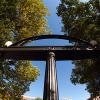UGA May Install a Temporary Ramp at the Arch

From left, Khalid Alsafadi, Carden Wyckoff and Marquise Lane.
Last week, Flagpole published a column by three mobility-impaired University of Georgia students asking for a ramp at the iconic Arch so they can participate in the tradition of walking or rolling through it after graduation like other students.
Today, UGA announced that, while it will not install a permanent ramp, a temporary platform will be erected at graduation so that people in wheelchairs may pass through the Arch. From university spokesman Tom Jackson:
The historic cast-iron Arch at the entrance to the University of Georgia’s North Campus dates from 1858 and is patterned after the Great Seal of the State of Georgia. Its iconic columns represent the state motto: “Wisdom, Justice, Moderation.” The steps leading to the Arch were installed in 1900, and the site has been in its current configuration since 1946. The site, including the steps, walls and the Arch itself, is historically significant to both the university and the State of Georgia.
The Americans with Disabilities Act requires reasonable accommodation be provided to public facilities for access by disabled persons. Because the Arch qualifies as an historical landmark, however, the National Historic Preservation Act requires the university to consider whether alterations can be made without threatening the historical significance of the site.
Previous reviews have determined that the Arch is accessible in its current configuration. People with disabilities may approach the Arch from the campus side, touch it, and have their photo taken beneath it. Because the Arch stands at the top of a series of steps, a wheelchair can stop beneath the Arch but cannot pass through it. While some students choose not to walk through the Arch until after graduation, the university does not sponsor any program or activity that requires or encourages students or alumni to pass through the Arch.
After thorough review, the university has determined that there is no viable option for further permanent accommodation at the Arch that would not have an adverse effect by diminishing the historical integrity of the site. In discussions with concerned students, the university has offered to explore the temporary erection of a platform on a day following spring commencement each year, whereby persons in wheelchairs could pass through the Arch. Because this platform would alter the appearance of the site, it would necessarily be temporary in order to preserve historical integrity.
The University of Georgia has a strong record and has been recognized at the state and national levels for its efforts in historic preservation and in making numerous landmark campus buildings accessible for people with disabilities. Such work has been accomplished in recent years in Old College, New College, the Chapel, Candler Hall, Meigs Hall, Terrell Hall, the Administration Building, and the first floors of Demosthenian Hall and the Holmes/Hunter Academic Building. This year’s Georgia General Assembly has approved funding to complete accessibility improvements to Baldwin Hall. This continues the university’s ongoing focus of its accessibility efforts on academic and administrative buildings.












comments